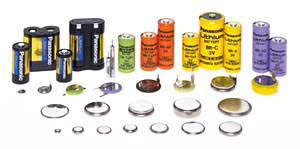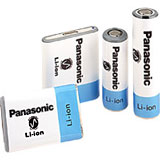How to choose the right power for your PDA
This article - the sources of power for your PDA. The more you know about batteries, the better for you. Especially if you use a wireless connection or if you have one of those energy-modems, which can shorten the battery life of up to 20 minutes.
The classification of power sources
Known two types of batteries: no charge and battery.
| Nepodzaryazhayuschiesya (batteries): | Batteries: |
- Alkaline - Alkaline
- Lithium - Lithium
| - NiCad - Nickel Cadmium
- NiMH - Nickel Metal Hydride
- Lithium Ion - Lithium batteries yonnye
- Renewable Alkaline - Alkaline batteries
|
Power source
There are two main options related to our topic: Voltage (V) and capacity (milliamp hour (mAh)). Tension - a force with which the battery generates current, capacitance - the amount of electrical energy, which selects the battery under certain discharge conditions, expressed in mA / h. This means that if you have two batteries of 1,5 V, one of which is capacity of 2000 mAh, and another - 2500 mAh, the battery with a capacity of 2500 mA / h under the same load currents will be working longer. That does not mean that elements with higher capacities work better. Depending on the load batteries behave differently. Memory cards and modems are a heavy load for power supplies. If you enable large loads observed voltage drop on the new alkaline batteries, because they react to bursts of energy consumption is not as good as lithium, NiSad and NiMH batteries.
Milliamp hour (mAh)
Most of the PDA consumes about 200 mA / h. CPC - 3-volt device, and two AA batteries just give a total of 3 volts. Divide the battery capacity (2600 mAChch for two AA alkaline batteries) to power consumption and you'll get at work. If you are using energy-intensive components, such as card PCMCIA, do not forget that battery life is reduced. This formula does not apply to alkaline batteries. They are estimated by the manufacturer, usually up to a limit point, but the PDA stops working well before this deadline.
Voltage
Voltage - similar horsepower in the engine. We compare the 4-cylinder car with 120 hp with a truck with 250 horsepower, pulling a heavy boat and trailer. While both beautifully moving on a horizontal surface, the power of the car becomes insufficient when driving on a hill. At the same speed both vehicles should pull trailer up the hill with the same force. But one of them has a greater capacity for the job. The same applies to power supplies. PCMCIA card for their work requires 5V-supply. Therefore, although 5-volt source would be more convenient, it is necessary to convert the voltage 3-volt power source PDA in a 5-volt. In this case, the work is harder in these conditions, the element quickly, "sit down".
Alkaline Battery (Alkaline)
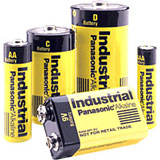 |
Alkaline batteries are statistically stable. Batteries are available with the options typically 1.5 V and 2600 mA / h. They have a long shelf life (90% after five years), but begin to "sit down" from the first moment of use. Rated voltage of 1.5V, but during operation it is reduced. Since the dilution rate is constant and known, you can measure the voltage and determine how much time the battery to work. This - the principle of the control program supply CE Power Manager. Capacity of alkaline batteries is almost exhausted at approximately 0.9 V. Your PDA will not work at such a low voltage.This point should be considered when using alkaline batteries. For what the lowest voltage of the CPC will work? Approximately 1.1V. But there is a positive side, you can take the "dead" batteries from your PDA and still used where it takes less current consumption (eg portable CD-player, etc.). Batteries of different manufacturers differ from each other, they react differently to the peaks of power consumption. When using a new alkaline batteries when attaching a modem or memory card to display a warning for reducing power supply voltages, it is likely that these batteries are not very well do their work. And before you curse your device, try different batteries. This is especially true for some batteries, nominal voltage which is equal to 1.2V.
Lithium power source (Lithium)
Many companies produce lithium batteries. These power supplies have a long shelf life (90% in 10 years). Lithium batteries maintain a constant voltage throughout the battery life, and work well with large loads. Like alkaline, they have high power (2600 mAChch), and their starting voltage - 1.5V. Lithium batteries work as long as they do not run down almost completely so that you can use almost all the rated battery capacity. When these batteries die, they die quickly. Due to the fact that their discharge characteristics are not known CE Power Manager, the program does not work with these batteries. She tells you that the battery is still good. But by the time the CE Power Manager says that the batteries are hooked, you're already on the verge of switching to backup power. Depending on your PDA, it should not be a problem. The most that you can lose - data that is stored in memory, but the information is recorded on a nonvolatile media CPC should not be lost. Of course, we should always remember the timely synchronization with your desktop PC and backups.
Nickel-cadmium rechargeable batteries (NiCad)
NiCad (nickel-cadmium power sources) - the most commonly used batteries today. They have many good features, and they work for a long time. You can buy batteries, NiCad and charger available, and use them instead of batteries AA.
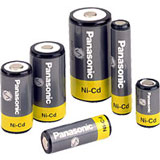 |
They are much more expensive than lithium and alkaline batteries. Nickel-cadmium power sources work just as well as lithium batteries, but they do not die so quickly. Their rated voltage - 1.25V, and they keep it for life batteries. They respond well to peaks of energy consumption, which means ensuring reliable operation in different applications. Available in different brands of batteries, Radio Shack, for example, offers a battery life of 650 and 850mA / h. Nickel-cadmium batteries have several disadvantages. Their power - far less power, lithium and alkaline batteries, and they have high self-discharge - up to 10% during the first 24 hours. Also, in order to get the full potential of the battery, you need every time ensure that they are fully discharged. Another drawback - it's "memory" effect, which consists in the enlargement of the crystalline formation of the working substance battery and, consequently, a decrease in active surface area and the actual battery capacity. As crystals grow, the nominal battery capacity decreases with time. (For a complete discharge of batteries leads to the unbundling of crystalline formations and increase the real capacity of the battery.) And, finally, the information for the fighters for a cleaner environment: nickel-cadmium power sources of heavy metals - cadmium, which is a major pollutant.
Nickel-metal hydride power (NiMH)
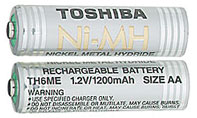 |
The next popular type of rechargeable batteries - nickel metal hydride (NiMH) batteries. Developer NiMH batteries are attractive because they have the energy density is much higher than that of NiSad. For example, at one and the same size NiMH battery has twice the capacity than NiSad battery power. Like NiCad, NiMH batteries hold the rated voltage for very long, and then quickly sit down. NiMH batteries, as well as NiCad, do not respond to spikes in energy consumption, level of self-discharge NiMH batteries have approximately 1.5 times greater than that of NiCad, the number of charge / discharge cycles less (about 500), plus they generate more heat during charge. Despite all these shortcomings, the nickel-metal hydride power gained enough market share. People using the battery, do not think about the expiration date (though self-discharge and is critical for recharging). They are interested in power and energy. Unlike nickel-cadmium batteries with their effect of "memory", NiMH batteries when frequent charging only work better. Besides, they do not contain heavy metals.
Li-yonnye power supply (Li-Ion)
After a rough start in the commercial market, Li-yonnye power begin to gain popularity. Li-yonnye batteries are a combination of the best qualities of NiSad and NiMH. They have low self-discharge, they are environmentally friendly, these power supplies there is no "memory" effect, and they have a large number of charge / discharge cycles. In addition, they respond well to peaks of energy consumption. The chemical composition of these sources of power makes them the easiest of all the batteries in that they have the highest energy density. Since the composition of the battery is changeable Lithium-yonnye sources are difficult to operate. Therefore, the batteries contain internal circuitry that controls the temperature of the element during charging. The scheme also limits the maximum current charge and discharge. In this regard, lithium batteries yonnye - one of the most expensive batteries for PDAs.
Chargers (Chargers)
 |
Chargers - more complex devices than most people think. First, the charger must provide the necessary current for optimum charging. Secondly, it must limit the voltage to prevent "recharge." Third, the charger must be able to balance the charge current in order to avoid high temperatures during charging. Too high temperature and gases released during charging the battery - the disastrous conditions for the battery. In addition, the charger should take into account self-discharge the battery at full charge it. It's just that, resulting in NiCad and NiMH batteries lose 10-15% of charge within 24 hours after fully charged. To reach full charge, the charger should reimburse it self-discharge. Since the chemical composition of different cell types is different, it is important that the charger was specially created for each type of battery. This is the reason that for each battery in your house - your charger: for telephone, computer, PDA, etc. When using the chargers are not designed for this battery, you risk damage or even blow up something.
Battery depletion
It is known that the PCMCIA-modem devastatingly affect the performance of batteries PDA.They require up to 5.8V for normal operation at 5.2V minimum. Why? Phone companies use a standard analog telephone signal amplitude of 3-6B. Persuaded phone companies to lower the standard around the world is impossible. And by the way, even software modems should make this phone a signal. Wireless devices also entails a quick waste of battery power. Requirements modem we are not considering. When dialing a cell phone require 4.8V or more. Do not expect the batteries on your PDA, they will pull a wireless modem. Now let's talk about color. All devices are CE 1.0 have monochrome screens. HP first entered the market with color screens. It was followed by Sharp, and now most manufacturers follow this model. Energy consumption in the device with a color screen about the same as that of a monochrome handheld with the backlight on. For this reason, most color handheld uses a NiMH or Li-yonnye batteries, not alkaline. Sources, Materials:
Pen Computing
The authors, translation:
HPCru
Gene Quickel
